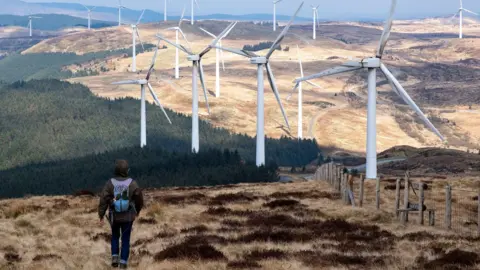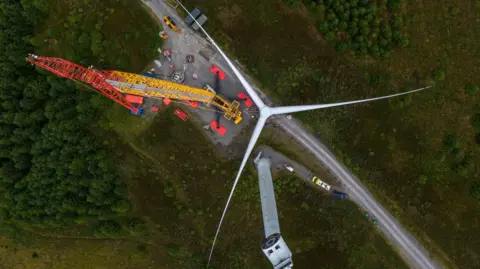Sites chosen for new state-backed Welsh windfarms
 Mike Kemp
Mike KempWales' new publicly-owned renewable energy developer has announced where it plans to build its first wind farm projects, promising hundreds of jobs.
Three sites have been selected, with the potential to generate enough clean electricity to power about a quarter of Welsh homes.
Trydan Gwyrdd Cymru was set up by the Welsh government to speed up the delivery of renewable energy projects on public land while ensuring the profits stayed in Wales.
But the Campaign for the Protection of Rural Wales (CPRW) questioned why so many onshore wind farms were needed when Wales had "enormous potential" for schemes to be built out at sea.
Trydan Gwyrdd Cymru, which means Green Electricity Wales in Welsh, was launched in 2024, with the aim of developing 1 GW worth of new renewable energy schemes on government-owned land by 2040.
Ministers had been inspired by similar state-backed firms such as Sweden's Vattenfall, which owns Wales' largest onshore windfarm - Pen-y-Cymoedd.
Having the country's own renewable energy developer means profits generated by Wales' wind can be retained and reinvested locally in communities and public services, the government argues.
 Carl Court / Getty
Carl Court / GettyThe company has now unveiled its first three proposed wind farms, in north, south and west Wales.
Clocaenog Dau wind farm will see 67 turbines built near Llyn Brenig, along the border between Conwy and Denbighshire.
Glyn Cothi wind farm, near Brechfa in Carmarthenshire, will have 27 turbines.
Carreg Wen wind farm, between Aberdare and Maerdy in Rhondda Cynon Taf, will be made up of 18 turbines.
Should all three make it through the planning process as well as securing connection to the grid, they will generate enough electricity to power the average needs of 350,000 homes.
The building work is anticipated to cost £500m, creating about 650 construction jobs.
Forty direct and 55 indirect jobs are also promised over the wind farms' 35-year operational lifetime.

Ministers said the schemes would help meet the growing need for clean energy in Wales.
Electricity demand is projected to nearly triple by 2050, fuelling the switch to electric vehicles, heat pumps and other low carbon technologies.
The Welsh government has set a target for Wales to generate enough renewable electricity to meet 70% of what's used in Wales by 2030, rising to 100% by 2035.
What about pylons?
Two of the projects already have an offer of connection to the grid network.
There are plans for a wooden pole line to connect the Glyn Cothi wind farm to a proposed new substation in Llandyfaelog, Carmarthenshire.
Similarly a wooden pole line would run from the Carreg Wen wind farm to a planned new substation near Hirwaun, Rhondda Cynon Taf.
Both substation projects – as well as the prospect of more overhead transmission lines - have already proved controversial locally.
Trydan Gwyrdd Cymru says it will begin a series of public information and engagement events later this year, with the aim of submitting planning applications in 2027.
"Communities will be involved and funding will support local priorities," said chief executive Richard Evans.
"With Trydan driving development, and with the profits from this investment retained in Wales, we have a unique opportunity to optimise the projects and the multiple benefits they bring."
Energy Secretary Rebecca Evans added: "By developing these projects on the Welsh government woodland estate, we're making best use of our public land to tackle the climate emergency and create sustainable economic opportunities."
Natural Resources Wales (NRW), which manages the land where the turbines will be built, said it would ensure all infrastructure was "integrated carefully into the working forest".
Tree clearance will be kept to a minimum, environmentally sensitive features will be protected, and any areas cleared of trees will be replaced through our Compensatory Planting Programme," explained Elsie Grace of NRW.
"Vital timber production and environmental protection can continue, while additional revenues are generated by the wind farm projects," she said.

Jonathan Dean from the CPRW warned there would be local opposition.
"I think the local communities will have problems with them, because they will be of an unprecedented scale," he said.
"The biggest wind turbine in Wales is currently under 150m (tall), these will be at least 200m - it's another step up."
He said the group was supportive of green energy and not against the use of wind turbines, but that there was "enormous potential" to site these out at sea.
"We really don't see that there is any need to put them in as many places onshore as is being planned."
